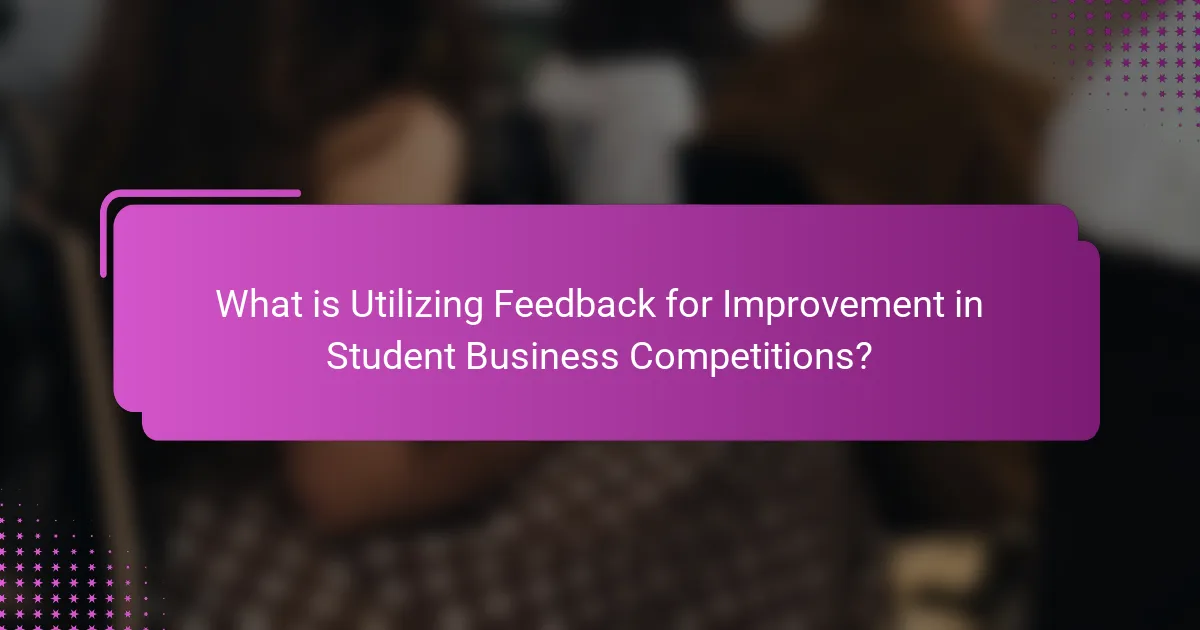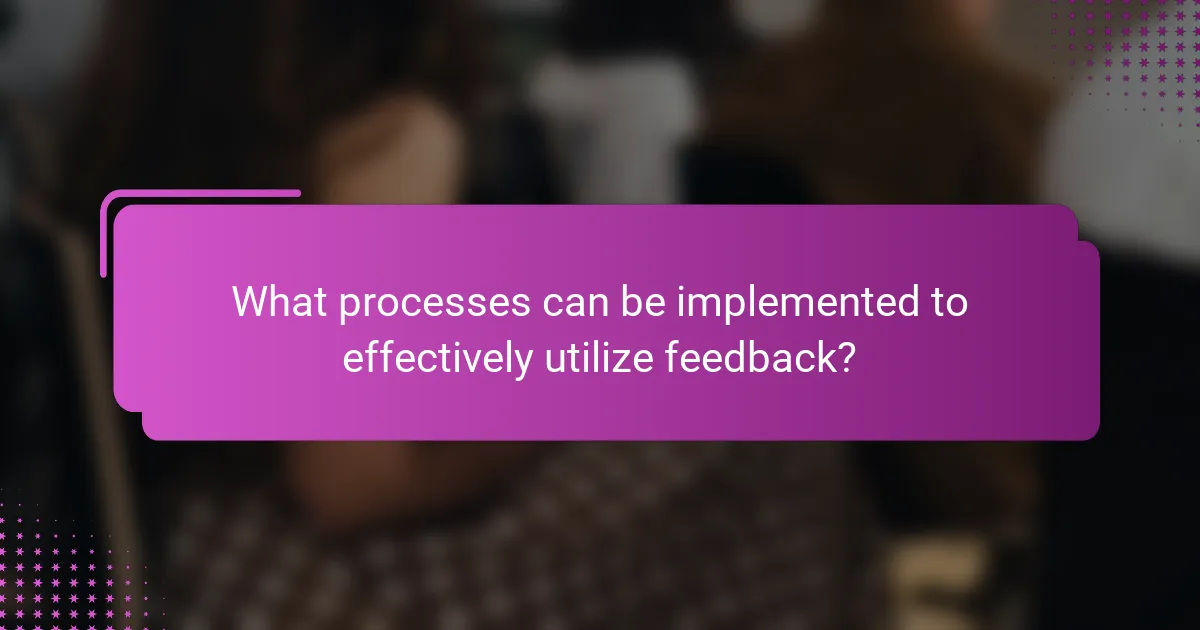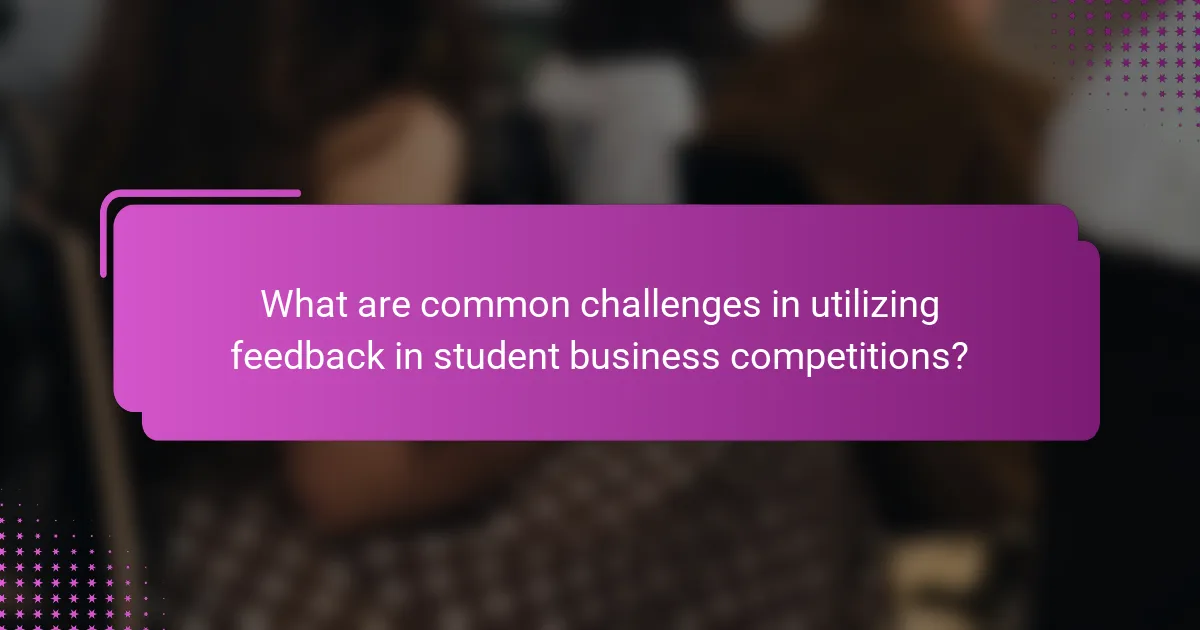Utilizing feedback is crucial for improvement in student business competitions, as it involves gathering insights from judges and peers to enhance performance. This feedback acts as a mechanism for identifying strengths and weaknesses, allowing students to refine their strategies and presentations. Structured feedback processes are essential, requiring clear objectives, systematic collection from diverse sources, and categorization into actionable themes. Challenges such as misinterpretation of feedback, lack of actionable insights, emotional responses to criticism, and time constraints can hinder effective implementation. Addressing these challenges is vital for fostering continuous learning and adaptation in competitive environments.

What is Utilizing Feedback for Improvement in Student Business Competitions?
Utilizing feedback for improvement in student business competitions involves collecting insights from judges and peers to enhance performance. Feedback serves as a tool for identifying strengths and weaknesses. Students can analyze this feedback to refine their strategies and presentations. Engaging with constructive criticism fosters growth and skill development. Research shows that organizations utilizing feedback improve their outcomes by 20% on average. This process encourages continuous learning and adaptation in competitive environments.
How does feedback play a role in student business competitions?
Feedback is essential in student business competitions as it enhances learning and performance. It provides participants with insights into their strengths and weaknesses. Constructive criticism helps students refine their ideas and strategies. Feedback from judges can lead to improved presentations and business plans. Peer feedback fosters collaboration and diverse perspectives. Regular feedback loops encourage continuous improvement throughout the competition. Research indicates that feedback significantly boosts student engagement and motivation. Effective feedback ultimately contributes to better outcomes in competitions.
What types of feedback are typically provided in these competitions?
In student business competitions, feedback typically includes judges’ evaluations, peer reviews, and mentor insights. Judges’ evaluations provide scores and comments based on specific criteria like presentation, innovation, and feasibility. Peer reviews offer perspectives from fellow participants, highlighting strengths and areas for improvement. Mentor insights give personalized advice based on experience and expertise in the field. This structured feedback helps participants understand their performance and refine their business strategies.
How can feedback be categorized based on its source?
Feedback can be categorized based on its source into three main types: internal, external, and peer. Internal feedback comes from within the organization or team, such as self-assessments or reflections. External feedback is provided by outside stakeholders, such as judges, mentors, or industry professionals. Peer feedback is given by fellow participants or team members, offering insights from shared experiences. Each type of feedback serves a unique purpose in the improvement process. Internal feedback fosters self-awareness and personal growth. External feedback provides an objective perspective and industry standards. Peer feedback encourages collaboration and shared learning. This categorization helps teams focus on specific areas for improvement based on the source of the feedback.
Why is feedback important for participants in student business competitions?
Feedback is important for participants in student business competitions because it provides essential insights into their performance. Participants can identify strengths and weaknesses through constructive criticism. This information helps them refine their business strategies and presentation skills. Feedback also fosters a growth mindset, encouraging students to learn from their experiences. Moreover, it enhances their understanding of market dynamics and competition. According to research, 70% of individuals improve their performance when they receive timely feedback. This statistic underscores the value of feedback in driving personal and professional development in competitive environments.
What impact does constructive feedback have on student performance?
Constructive feedback significantly enhances student performance. It provides specific guidance that helps students identify strengths and weaknesses. Research shows that students who receive constructive feedback tend to improve their grades and skills. A study published in the “Journal of Educational Psychology” found that timely feedback increases student motivation and engagement. Constructive feedback fosters a growth mindset, encouraging students to embrace challenges. This type of feedback also promotes self-reflection, allowing students to assess their progress. Overall, constructive feedback is essential for effective learning and skill development in educational settings.
How does feedback contribute to the learning process in business competitions?
Feedback enhances the learning process in business competitions by providing critical insights into performance. It allows participants to identify strengths and weaknesses in their strategies. Constructive feedback helps refine ideas and approaches. This iterative process fosters continuous improvement. Research indicates that feedback leads to better decision-making and innovation. In a study by Hattie and Timperley, effective feedback significantly improved learning outcomes. Participants who actively seek and apply feedback tend to outperform their peers. Thus, feedback is essential for growth and success in competitive environments.

What processes can be implemented to effectively utilize feedback?
Implementing structured feedback processes is essential for effective utilization. First, establish clear objectives for feedback. This ensures that the feedback aligns with desired outcomes. Next, collect feedback systematically from multiple sources, such as judges, peers, and mentors. This diverse input provides a comprehensive view of performance.
After collection, categorize feedback into actionable themes. This helps in identifying common strengths and weaknesses. Prioritize the feedback based on its relevance to the competition goals. Create an action plan that outlines specific steps to address the feedback.
Finally, monitor progress and reassess the implementation of changes regularly. Research shows that structured feedback processes lead to improved performance in competitive settings. For instance, a study by Hattie and Timperley (2007) highlights that effective feedback significantly enhances learning outcomes.
How can students collect feedback during competitions?
Students can collect feedback during competitions by using structured surveys and direct observation. Surveys can be distributed immediately after presentations. These surveys should include specific questions about performance and areas for improvement. Direct observation involves noting judges’ comments and audience reactions. Students can also engage in informal discussions with judges after the event. Recording these interactions can provide valuable insights. Additionally, peer feedback can be gathered through group discussions post-competition. This multi-faceted approach ensures comprehensive feedback collection.
What methods are effective for gathering feedback from judges and peers?
Surveys and questionnaires are effective methods for gathering feedback from judges and peers. They allow participants to provide structured responses on specific criteria. This method can capture quantitative data, making it easier to analyze trends. Additionally, interviews offer a more in-depth understanding of feedback. They create opportunities for open dialogue and clarification of points. Focus groups can also be beneficial. They facilitate discussion among peers and judges, fostering diverse perspectives. Observational methods provide real-time insights into performance. Observers can note strengths and weaknesses during presentations or competitions. Each of these methods contributes to a comprehensive understanding of performance and areas for improvement.
How can technology facilitate the feedback collection process?
Technology can facilitate the feedback collection process by providing digital platforms for easy data gathering. Online surveys can be created and distributed quickly to participants. These surveys allow for immediate and anonymous responses, increasing participation rates. Data analytics tools can then analyze the collected feedback efficiently. This analysis helps identify trends and areas for improvement. Additionally, mobile applications can enable real-time feedback during events. This immediacy allows for timely adjustments and improvements. Research shows that digital feedback methods can increase response rates by up to 30% compared to traditional methods.
What strategies can students adopt to implement feedback for improvement?
Students can adopt several strategies to implement feedback for improvement. First, they should actively listen to feedback during evaluations. This ensures they understand the points being made. Next, students should categorize feedback into actionable items. This will help prioritize which areas to address first. Additionally, they can create a specific action plan based on the feedback. This plan should outline steps for improvement and set deadlines.
Moreover, students should seek clarification on feedback when necessary. This will help eliminate misunderstandings. They can also engage in self-reflection after receiving feedback. This practice allows them to assess their own performance critically. Finally, students should track their progress over time. This will provide evidence of improvement and reinforce their learning journey.
How should students prioritize feedback for actionable insights?
Students should prioritize feedback by assessing its relevance, specificity, and applicability to their goals. They should first identify feedback that aligns with their objectives in the competition. Specific feedback provides clear areas for improvement and is more actionable. Students should then categorize feedback into immediate actions and long-term strategies. Immediate actions can lead to quick wins, while long-term strategies support sustained growth. Additionally, students should seek feedback from diverse sources, such as judges, peers, and mentors, to gain multiple perspectives. This comprehensive approach ensures that students focus on feedback that will enhance their performance effectively. Prioritizing feedback in this structured manner increases the likelihood of achieving actionable insights.
What role does self-reflection play in utilizing feedback effectively?
Self-reflection is crucial for effectively utilizing feedback. It allows individuals to critically assess their performance and identify areas for improvement. Engaging in self-reflection helps students understand the context of the feedback received. It enables them to connect feedback to their specific actions and decisions during competitions. Research shows that self-reflection enhances learning outcomes. A study by Moon (2004) highlights that reflective practices lead to deeper understanding and application of feedback. This process fosters a growth mindset, encouraging students to view feedback as a tool for development. Ultimately, self-reflection transforms feedback into actionable insights for future performance.

What are common challenges in utilizing feedback in student business competitions?
Common challenges in utilizing feedback in student business competitions include misinterpretation of feedback, lack of actionable insights, and emotional responses to criticism. Misinterpretation occurs when students misunderstand the feedback provided, leading to ineffective changes. Lack of actionable insights happens when feedback is vague and does not specify clear steps for improvement. Emotional responses to criticism can hinder students from accepting constructive feedback, affecting their ability to learn and adapt. Additionally, time constraints often limit students’ ability to implement feedback effectively before competition deadlines. These challenges can significantly impact the overall learning experience and performance in competitions.
What barriers do students face when interpreting feedback?
Students face several barriers when interpreting feedback. One significant barrier is a lack of clarity in the feedback provided. Ambiguous comments can lead to confusion about expectations. Emotional responses to criticism can also hinder understanding. Students may feel defensive, preventing them from processing the feedback objectively. Additionally, varying feedback styles from different judges can create inconsistency. This inconsistency can make it challenging for students to identify areas for improvement. Limited experience in receiving constructive criticism may further complicate interpretation. Research indicates that students often struggle to translate feedback into actionable steps for growth.
How can emotional responses to feedback hinder improvement?
Emotional responses to feedback can hinder improvement by causing defensive reactions. When individuals feel criticized, they may shut down or reject the feedback. This defensiveness prevents them from fully understanding the constructive aspects of the feedback. Consequently, they miss opportunities for growth and learning. Research indicates that negative emotional responses can impair cognitive processing. This impairment limits the ability to reflect on feedback objectively. As a result, emotional reactions can create barriers to personal and professional development.
What misconceptions about feedback can affect student performance?
Misconceptions about feedback that can affect student performance include the belief that feedback is solely negative. This misconception can lead students to perceive feedback as a personal attack rather than a tool for improvement. Students may also think feedback is only valuable if it comes from authority figures, disregarding peer feedback. Additionally, some students believe that feedback should always be comprehensive, overlooking the importance of specific, targeted suggestions.
Research indicates that students who view feedback as a learning opportunity perform better academically. A study by Hattie and Timperley (2007) emphasizes that effective feedback enhances student learning when students understand its purpose. Misunderstanding feedback can result in decreased motivation and engagement, ultimately hindering performance in competitions.
Addressing these misconceptions can foster a more constructive approach to feedback, improving student outcomes in business competitions.
How can students overcome these challenges to maximize feedback utilization?
Students can overcome challenges to maximize feedback utilization by actively engaging with the feedback process. They should seek clarification on feedback points to ensure understanding. Implementing feedback in their work is crucial for improvement. Regularly reviewing past feedback helps students track their progress. Creating actionable plans based on feedback can enhance learning outcomes. Collaborating with peers for diverse perspectives on feedback is beneficial. Utilizing feedback tools or platforms can streamline the process. Research shows that students who actively engage with feedback improve their performance significantly.
What best practices should students follow to embrace feedback positively?
Students should actively listen to feedback to embrace it positively. This involves focusing on the speaker and not interrupting. Understanding the feedback fully is crucial. Students should ask clarifying questions if needed. They should also reflect on the feedback received. This helps in processing the information effectively. Maintaining a positive attitude is essential. Acknowledging that feedback is an opportunity for growth fosters a constructive mindset. Additionally, students should implement the feedback in their work. This not only shows appreciation but also enhances their skills. Consistent practice of these strategies leads to better performance in competitions.
How can mentorship enhance the feedback utilization process?
Mentorship enhances the feedback utilization process by providing guidance and support to mentees. Mentors help mentees interpret feedback effectively. They can clarify complex feedback points that may be confusing. Mentors also encourage mentees to reflect on feedback critically. This reflection fosters deeper understanding and application of the feedback. Additionally, mentors can share personal experiences related to similar feedback. This sharing can motivate mentees to act on the feedback received. Research shows that mentorship improves learning outcomes by increasing engagement with feedback. A study by Allen and Eby (2007) highlights the positive impact of mentorship on feedback processing in educational settings.
What are practical tips for effectively utilizing feedback in competitions?
To effectively utilize feedback in competitions, first categorize the feedback received. Organize it into strengths and areas for improvement. This helps clarify what aspects are working well and what needs enhancement. Next, prioritize actionable feedback. Focus on suggestions that can be realistically implemented before the next competition. Then, develop a plan to address the feedback. This plan should include specific steps and deadlines for making improvements. Additionally, seek clarification on feedback if needed. Understanding the context or reasoning behind comments can lead to better application. Finally, reflect on the changes made after implementing feedback. Assess whether these changes positively impacted performance in subsequent competitions. This iterative process fosters continuous improvement.
Utilizing feedback for improvement in student business competitions is the primary entity explored in this article. The content emphasizes the importance of feedback from judges, peers, and mentors in enhancing participants’ performance by identifying strengths and weaknesses. It discusses various types of feedback, effective methods for collection, and strategies for implementation, highlighting the role of self-reflection and mentorship in maximizing the benefits of feedback. Additionally, the article addresses common challenges faced by students in interpreting and utilizing feedback, providing practical tips for overcoming these barriers to foster continuous improvement in competitive settings.
